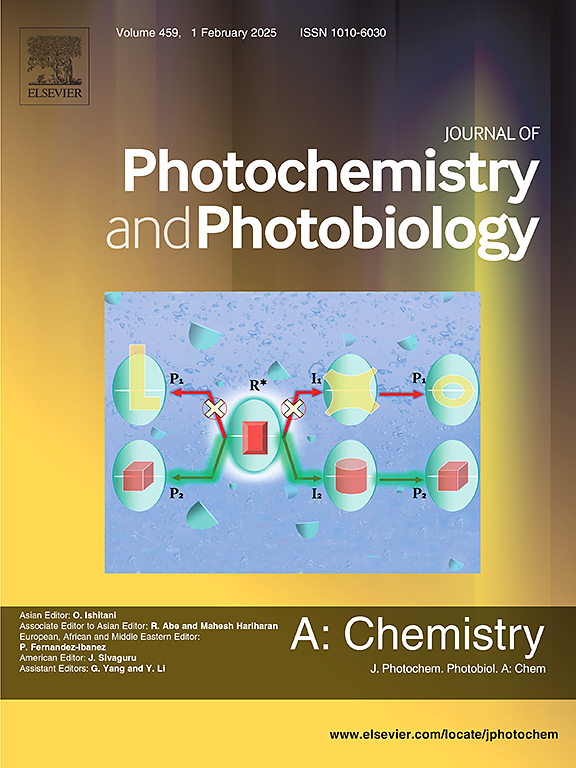Effect of ether chain length in the perylenediimide-based dimeric acceptors with asymmetric 6-(thien-2-yl)benzo[b]thiophene linker
IF 4.1
3区 化学
Q2 CHEMISTRY, PHYSICAL
Journal of Photochemistry and Photobiology A-chemistry
Pub Date : 2025-06-21
DOI:10.1016/j.jphotochem.2025.116589
引用次数: 0
Abstract
Asymmetric acceptors have gained the increasing attention because of the stronger intermolecular binding energy, the larger natural dipole moment, and the antiparallel packing. However, asymmetric perylene diimide (PDI) dimeric acceptors were not fully investigated. In this contribution, two asymmetric 6-(thien-2-yl)benzo[b]thiophene (T-BTh) core linked dimeric PDI acceptors, T-BTh-(PDI-OMe)2 and T-BTh-(PDI-EG)2, with the outside-bay methoxy (OMe) and 2-methxoyethanoxyl (EG) modified PDI-OMe and PDI-EG aromatic moieties as flanked wings, were developed to elucidate the effect of ether chain length. Extending the flexible ether chain from OMe to EG acquired a decreased thermo-stability, a weakened absorption response between 450 nm and 650 nm, a close solution state aggregation, a strengthened aggregation in both pristine and blend films, and a deepened ELUMO. Thus, the relatively shorter OMe ether chain modified PTB7-Th:T-BTh-(PDI-OMe)2-based device delivered a VOC of 0.84 V, a JSC of 6.62 mA cm−2 and an FF of 41.81 %, contributing to a winning PCE of 2.33 % and better storage device stability. In the similar testing condition, longer EG ether chain modified PTB7-Th:T-BTh-(PDI-EG)2-based device got the decreased PCE as low as 0.99 %. The decline in PCE could be primarily attributed to the deepened the ELUMO, the worse absorption, the reduced electron mobility resulting from poor miscibility, and the rougher surface morphology. When the electron donor PM6 was applied, T-BTh-(PDI-OMe)2-based device afforded the higher VOC of 0.96 V but reduced PCE of 1.61 %. These preliminary results implied that it should be cautious to extend the bay-position flexible ether chain, which would affect the molecular geometry, optoelectronic property, and further reduce device efficiency of the asymmetric core linked PDI-based dimers.

不对称6-(噻吩-2-基)苯并[b]噻吩连接剂对苝酰二亚胺基二聚体受体醚链长度的影响
不对称受体由于具有较强的分子间结合能、较大的自然偶极矩和反平行包装等特点而受到越来越多的关注。然而,不对称苝二亚胺(PDI)二聚体受体尚未得到充分的研究。本文研究了两个不对称的6-(噻吩-2-基)苯并[b]噻吩(T-BTh)核心连接的二聚体PDI受体,T-BTh-(PDI-OMe)2和T-BTh-(PDI-EG)2,以外湾甲氧基(OMe)和2-甲氧基乙氧基(EG)修饰的PDI-OMe和PDI-EG芳香部分为侧翼,以阐明醚链长度的影响。将柔性醚链从OMe延伸到EG,会导致热稳定性下降,450 nm到650 nm之间的吸收响应减弱,溶液态聚集紧密,原始膜和共混膜的聚集增强,ELUMO加深。因此,相对较短的OMe醚链修饰的PTB7-Th:T-BTh-(PDI-OMe)2基器件的VOC为0.84 V, JSC为6.62 mA cm - 2, FF为41.81%,PCE为2.33%,并且具有更好的存储器件稳定性。在相似的测试条件下,更长的EG醚链修饰的PTB7-Th:T-BTh-(PDI-EG)2基器件的PCE降低低至0.99%。PCE的下降主要是由于ELUMO加深、吸收变差、互溶性差导致电子迁移率降低以及表面形貌粗糙所致。当电子给体为PM6时,T-BTh-(PDI-OMe)2基器件的VOC为0.96 V, PCE降低了1.61%。这些初步结果表明,不对称核链pdi基二聚体的分子几何形状、光电性能和器件效率均受到影响,因此应谨慎延长海湾位柔性醚链。
本文章由计算机程序翻译,如有差异,请以英文原文为准。
求助全文
约1分钟内获得全文
求助全文
来源期刊
CiteScore
7.90
自引率
7.00%
发文量
580
审稿时长
48 days
期刊介绍:
JPPA publishes the results of fundamental studies on all aspects of chemical phenomena induced by interactions between light and molecules/matter of all kinds.
All systems capable of being described at the molecular or integrated multimolecular level are appropriate for the journal. This includes all molecular chemical species as well as biomolecular, supramolecular, polymer and other macromolecular systems, as well as solid state photochemistry. In addition, the journal publishes studies of semiconductor and other photoactive organic and inorganic materials, photocatalysis (organic, inorganic, supramolecular and superconductor).
The scope includes condensed and gas phase photochemistry, as well as synchrotron radiation chemistry. A broad range of processes and techniques in photochemistry are covered such as light induced energy, electron and proton transfer; nonlinear photochemical behavior; mechanistic investigation of photochemical reactions and identification of the products of photochemical reactions; quantum yield determinations and measurements of rate constants for primary and secondary photochemical processes; steady-state and time-resolved emission, ultrafast spectroscopic methods, single molecule spectroscopy, time resolved X-ray diffraction, luminescence microscopy, and scattering spectroscopy applied to photochemistry. Papers in emerging and applied areas such as luminescent sensors, electroluminescence, solar energy conversion, atmospheric photochemistry, environmental remediation, and related photocatalytic chemistry are also welcome.

 求助内容:
求助内容: 应助结果提醒方式:
应助结果提醒方式:


